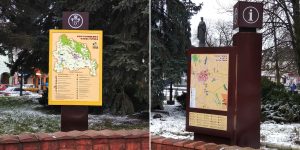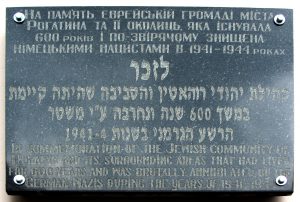![]() Ця сторінка також доступна українською.
Ця сторінка також доступна українською.
Due to progress in developing and installing physical signs for heritage in Rohatyn, both by the City of Rohatyn and by Rohatyn Jewish Heritage, a standalone project covering signage by our NGO is no longer needed. RJH will continue to develop and maintain Jewish heritage signs in partnership with the City, but those signs will be described and documented as part of other heritage projects, e.g. the old cemetery project, the new cemetery project, and the mass graves memorials project. Some signage developed and installed since Rohatyn Jewish Heritage was founded are briefly described here.
Direction Signs
At the beginning of 2021, the Rohatyn Opillya Museum of regional history led a project for the City of Rohatyn to design and install signs on city streets and at the town square directing pedestrians to sites of local heritage, including three of the Jewish burial sites: the old cemetery and both Holocaust mass grave sites. In addition, a large tourist map installed at Roksolana Square in the city center shows all four burial sites (including the new Jewish cemetery).
A tourist brochure available at the Rohatyn Opillya Museum and at City Hall duplicates the heritage features map at the town square and can guide visitors on foot or by car to all of the sites as well as parks, bus stations, and other helpful city services. Together the tourist signs, the town square map, and the tourist brochure provide much-needed information and direction to both visitors and Rohatyn residents alike; with greater knowledge of their city’s heritage, local people on the street and in shops can now also serve as guides to first-time visitors.
To date, no directional road signs to guide vehicle drivers to heritage sites in Rohatyn have been developed and installed, for the Jewish sites or for any other heritage. However, RJH has studied the current Ukrainian national standard for road signs and has developed conforming example designs for directional signs, and will support the City of Rohatyn when they are prepared to start a road sign project.
Information Signs
At several of the heritage sites, text on existing memorial monuments and plaques briefly summarizes the tragedy of the destruction of the Rohatyn Jewish community in dates and numbers. New information signs installed at the sites also speak to the prewar history of the Jewish community and explain the original purpose of those sites to aid in the renewal of Jewish memory in the city.
Both of the mass grave sites have Soviet-era (1980s) monuments with Ukrainian-language plaques which read simply “Victims of Fascism”, plus monuments erected in 1998 by Jewish descendants in partnership with the City of Rohatyn, each of which includes plaques with text in Ukrainian, Hebrew, and English, as shown here. There is also a plaque which was installed in the 1990s on the former Judenrat building in the wartime Jewish ghetto area (now part of a boarding school complex west of the town square).
Numerous examples of Jewish heritage information signs exist around Europe and the world to provide inspiration and guidance on design, fabrication, and installation of new signs with more historical information, images, etc. Especially in Ukraine, the international project ESJF European Jewish Cemeteries Initiative has been developing and installing information signs at Jewish cemeteries where they have completed protective fencing work over the past several years. In 2022 and 2023, Rohatyn Jewish Heritage partnered with ESJF to design, construct, and install trilingual information signs in front of Rohatyn’s two Jewish cemeteries, using historical data, translated texts, and heritage maps from RJH research.
The new signs include brief histories of the Jewish community of Rohatyn and of the cemetery sites themselves, plus historical images of Rohatyn Jewish women, men, and children from the interwar years, and a map identifying the Jewish heritage sites in the city. The signs also include QR codes linked to pages on this website with more information about the sites and the Jewish history of Rohatyn.

The new information signs installed at the old Jewish cemetery (left) and the new Jewish cemetery (right) in Rohatyn. Photos © RJH.





